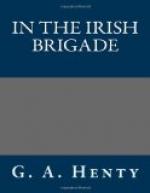Philip’s second line of cavalry gave but feeble support, and Stanhope’s horse soon had them all in confusion, and, driving them from the field, pursued them hotly. The fugitives dashed into their own infantry, who were just arriving in force, and their panic communicated itself to them, and a total rout took place. The pursuit was kept up until it was so dark that the troopers were unable to see each other’s faces, and they then halted, having defeated the Spanish without the aid of their infantry, which had not come up in time to take any part in the fight. Much of the baggage, together with tents, many cannon, and a quantity of ammunition, fell into the hands of the victors. Owing to the darkness, the number of prisoners taken was small.
O’Mahony and his troops had taken no part in the engagement, as, having arrived late on the previous evening after a long march, they were still at Lerida. It had not been deemed necessary to hurry them forward, as no battle was expected to take place for some days—as, indeed, would have been the case had the force sent forward arrived at the river before Stanhope.
The routed troops arrived under the shelter of the guns of Lerida. Charles did not attack them there, but, making a detour, seized several places in Aragon, with the intention of cutting the line by which Philip would probably retire, and forcing him to fight again. Philip, however, on his part, marched from Lerida in order to retire into Castile by way of Saragossa. Charles followed hotly, and a portion of his cavalry came up to the rear of the enemy in the defile of Penalva. Here the Spaniards posted a strong force of grenadiers, and the defile being too narrow for the cavalry to act, these dismounted, and a hot fight took place, in which both parties claimed the victory. However, Philip retired the same day in great haste. Charles, arriving three hours later, ate the dinner that had been prepared for his rival.
The Spaniards, covered by the defence of the pass, crossed the Ebro and posted themselves in a strong position within a mile of Saragossa. On the 21st of August Marshal Staremberg, with his generals, having reconnoitred their position, gave orders for the attack to take place the next morning, and at daybreak the cannon on both sides opened fire. General Stanhope, who commanded on the left wing, found that the enemy had the greater part of their cavalry facing him, and therefore strengthened his force by four battalions of foot and six squadrons of Portuguese horse.
The Spanish line ran obliquely, from the river on their left to a steep hill on their right, occupied by their cavalry and a battery of artillery. These, therefore, were much nearer to the attacking force than were those on the plain.




